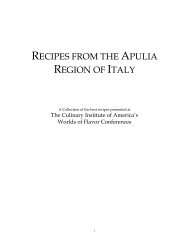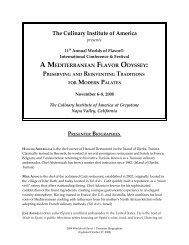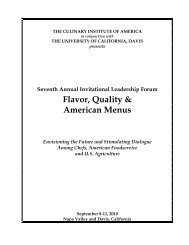Authentic Flavors for American Menus - CIAProChef.com
Authentic Flavors for American Menus - CIAProChef.com
Authentic Flavors for American Menus - CIAProChef.com
You also want an ePaper? Increase the reach of your titles
YUMPU automatically turns print PDFs into web optimized ePapers that Google loves.
Mushrooms In addition to the now-familiar dried shiitake mushroom (Lentinus edodes) with its aggressive flavor,<br />
the chewy tree ear (Auricularia polytricha)—also known as cloud ear or wood ear—is widely used. Tree ears don’t<br />
taste like much but they add a pleasing gelatinous texture to soups, stuffings, noodle dishes and vinegared<br />
salads.<br />
Oyster Sauce A dark brown, concentrated condiment made from oysters (or oyster flavoring), salt and<br />
cornstarch, oyster sauce adds depth and savoriness to Chinese stir-fries. Even a simple dish of steamed or stirfried<br />
broccoli seems rich and satisfying when drizzled with oyster sauce. Markets carry brands that differ<br />
considerably in quality and price; both Bruce Cost and Barbara Tropp suggest that the more expensive bottlings<br />
have better flavor. Less expensive products may be made with oyster flavoring, not real oysters.<br />
Preserved Vegetables The vegetable can be cabbage, mustard, turnip, radish or other members of the cabbage<br />
family. The preserving is done with salt or brine, followed by drying. The result is a wrinkled fermented pickle<br />
that, chopped and added in small quantities to stuffings, braises, soups, stir-fries and noodle dishes, adds a<br />
pungent, salty edge.<br />
Rice Noodles Dried rice vermicelli, also known as rice sticks, look like a tangle of bleached blonde hair; they<br />
must be soaked in hot water <strong>for</strong> a few minutes to soften them. The rehydrated off-white noodles are used in<br />
soups, salads, stuffings and stir-fries. Like bean threads, they can also be deep-fried in hot oil to make a puffed,<br />
crunchy nest <strong>for</strong> stir-fries. Rice sticks also <strong>com</strong>e in medium and wide widths <strong>for</strong> soups and stir-fries. Sha he fen (a<br />
floppy, fresh rice noodle sheet) is often rolled around a filling of shrimp or pork, then steamed, or cut into<br />
ribbons and stir-fried.<br />
Rice Wine Chinese rice wine from the city of Shao-Hsing has a nuttier, more sherry-like taste than Japanese rice<br />
wine, but it is fundamental to the cooking as a <strong>com</strong>ponent of sauces, marinades, steamed seafood dishes,<br />
stuffings and braises. In China’s “drunken” dishes—using crab, shrimp or chicken—Shao-Hsing wine is the<br />
predominant ingredient in the sauce.<br />
Rock Sugar (rock candy) A golden lump sugar made from white sugar, brown sugar and honey, rock sugar is<br />
used in some Chinese dishes. Cooks use rock sugar with soy sauce-braised chicken and pork and with “redcooked”<br />
dishes. Barbara Tropp’s popular Master Sauce Chicken includes crushed rock sugar.<br />
Salted Black Beans These soft, salty black soybeans have been brined and fermented to produce their<br />
distinctive, winy flavor. Early agricultural records confirm that they are an ancient condiment, a soy product that<br />
predates even soy sauce. Chinese cooks mash or chop them lightly to release their flavor, then add them to<br />
steamed whole fish and shellfish, stir-fried vegetables and braised meats. Some brands are seasoned with ginger<br />
or five-spice powder.<br />
Sesame Oil Oil pressed from roasted sesame seeds, which give this oil a nutty aroma and rich dark color. The<br />
pale sesame oil available in some health food stores are made with unroasted seeds and have an entirely<br />
different character. Sesame oil is used primarily as a seasoning, or finishing, oil to be used in dipping sauces, in<br />
salad dressings or as a final drizzle in finished soups.<br />
Shrimp Sauce and Shrimp Paste Like anchovies in Italian cuisine, fermented shrimp sauce and shrimp paste<br />
contribute a salty, pronounced fishy note to many Chinese dishes. They are not <strong>for</strong> the timid. Some of these<br />
shrimp products are thick and spoonable; others are pastelike and sold as bricks. The cook breaks off a little and<br />
pounds it with other ingredients, then fries it in oil to release its flavor.<br />
Soy Sauce Familiar to Western cooks as China’s answer to salt, soy sauce has more permutations than most<br />
Westerners know. Made from fermented soybeans, it also contains wheat in varying proportions and,<br />
sometimes, sugar or molasses. These other ingredients and different aging regimens give soy sauces their varied<br />
characters. Chinese manufacturers produce both light and dark soy sauces. The dark soy is aged longer and<br />
contains some molasses, and it’s saltier than the lighter version. Cooks use dark soy in noodles, red meats and<br />
heartier braises that can support its stronger character; they save light soy <strong>for</strong> more delicate dishes such as fish<br />
preparations, vegetables and dipping sauces.<br />
Szechwan Peppercorns These dried reddish-brown pods are unrelated to black peppercorns but they have a<br />
similarly fragrant, warming character. Cooks heat the peppercorns with salt to release their aroma, then grind<br />
the two seasonings to make an aromatic dipping salt <strong>for</strong> fried or roasted meats. The peppercorns are also<br />
warmed in oil, then strained out, to make a flavored oil used <strong>for</strong> stir-fries and salads.<br />
44<br />
WORLDS OF FLAVOR CONFERENCE AND FESTIVAL V1.1 THE CULINARY INSTITUTE OF AMERICA ®<br />
SAVORING ASIA—AUTHENTIC FLAVORS FOR AMERICAN MENUS










